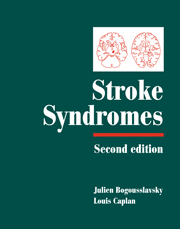Book contents
- Frontmatter
- Contents
- List of contributors
- Preface
- PART I CLINICAL MANIFESTATIONS
- 1 Stroke onset and courses
- 2 Clinical types of transient ischemic attacks
- 3 Hemiparesis and other types of motor weakness
- 4 Sensory abnormality
- 5 Cerebellar ataxia
- 6 Headache: stroke symptoms and signs
- 7 Eye movement abnormalities
- 8 Cerebral visual dysfunction
- 9 Visual symptoms (eye)
- 10 Vestibular syndromes and vertigo
- 11 Auditory disorders in stroke
- 12 Abnormal movements
- 13 Seizures and stroke
- 14 Disturbances of consciousness and sleep–wake functions
- 15 Aphasia and stroke
- 16 Agitation and delirium
- 17 Frontal lobe stroke syndromes
- 18 Memory loss
- 19 Neurobehavioural aspects of deep hemisphere stroke
- 20 Right hemisphere syndromes
- 21 Poststroke dementia
- 22 Disorders of mood behaviour
- 23 Agnosias, apraxias and callosal disconnection syndromes
- 24 Muscle, peripheral nerve and autonomic changes
- 25 Dysarthria
- 26 Dysphagia and aspiration syndromes
- 27 Respiratory dysfunction
- 28 Clinical aspects and correlates of stroke recovery
- PART II VASCULAR TOPOGRAPHIC SYNDROMES
- Index
- Plate section
3 - Hemiparesis and other types of motor weakness
from PART I - CLINICAL MANIFESTATIONS
Published online by Cambridge University Press: 17 May 2010
- Frontmatter
- Contents
- List of contributors
- Preface
- PART I CLINICAL MANIFESTATIONS
- 1 Stroke onset and courses
- 2 Clinical types of transient ischemic attacks
- 3 Hemiparesis and other types of motor weakness
- 4 Sensory abnormality
- 5 Cerebellar ataxia
- 6 Headache: stroke symptoms and signs
- 7 Eye movement abnormalities
- 8 Cerebral visual dysfunction
- 9 Visual symptoms (eye)
- 10 Vestibular syndromes and vertigo
- 11 Auditory disorders in stroke
- 12 Abnormal movements
- 13 Seizures and stroke
- 14 Disturbances of consciousness and sleep–wake functions
- 15 Aphasia and stroke
- 16 Agitation and delirium
- 17 Frontal lobe stroke syndromes
- 18 Memory loss
- 19 Neurobehavioural aspects of deep hemisphere stroke
- 20 Right hemisphere syndromes
- 21 Poststroke dementia
- 22 Disorders of mood behaviour
- 23 Agnosias, apraxias and callosal disconnection syndromes
- 24 Muscle, peripheral nerve and autonomic changes
- 25 Dysarthria
- 26 Dysphagia and aspiration syndromes
- 27 Respiratory dysfunction
- 28 Clinical aspects and correlates of stroke recovery
- PART II VASCULAR TOPOGRAPHIC SYNDROMES
- Index
- Plate section
Summary
Introduction
Motor weakness, isolated or in association with other symptoms or signs, is the commonest problem of stroke patients. In epidemiological stroke studies, motor deficit (paresis/paralysis) is found in 80–90% of all patients (Herman et al., 1982; Bogousslavsky et al., 1988; Libman et al., 1992). There have been attempts to explain this fact using a variety of distinct arguments: (i) motor weakness is easily recorded by the patient, family, or physician; (ii) it can be caused by a stroke anywhere along the corticospinal pathways, from the cerebral cortex to the spinal cord; (iii) the most frequent types of stroke (lacunar, cardioembolic) have a ‘predilection’ for anatomic motor centres or tracts.
Motor-weakness profiles and associated abnormalities can be helpful in predicting stroke subtypes (localization, cause) in the acute phase, which is essential for etiologic diagnostic strategies, for treatment, and for prognosis in individual patients. Motor weakness is also a major element in the rating scales for clinical stroke, because it is important for daily living activities, it is not difficult to evaluate, and its assessment has shown a good interobserver reliability.
Anatomic considerations
The motor cortex is not confined to the large motor cells of Betz in the fifth layer of the precentral gyrus (primary motor cortex), as formulated at the turn of the century. Experimental studies in monkeys have indicated that only 60% of the corticospinal fibres arise from the primary motor cortex and the premotor and supplementary motor areas. The remaining fibres arise mainly from the postcentral gyrus and parietal cortex.
- Type
- Chapter
- Information
- Stroke Syndromes , pp. 22 - 33Publisher: Cambridge University PressPrint publication year: 2001
- 3
- Cited by



